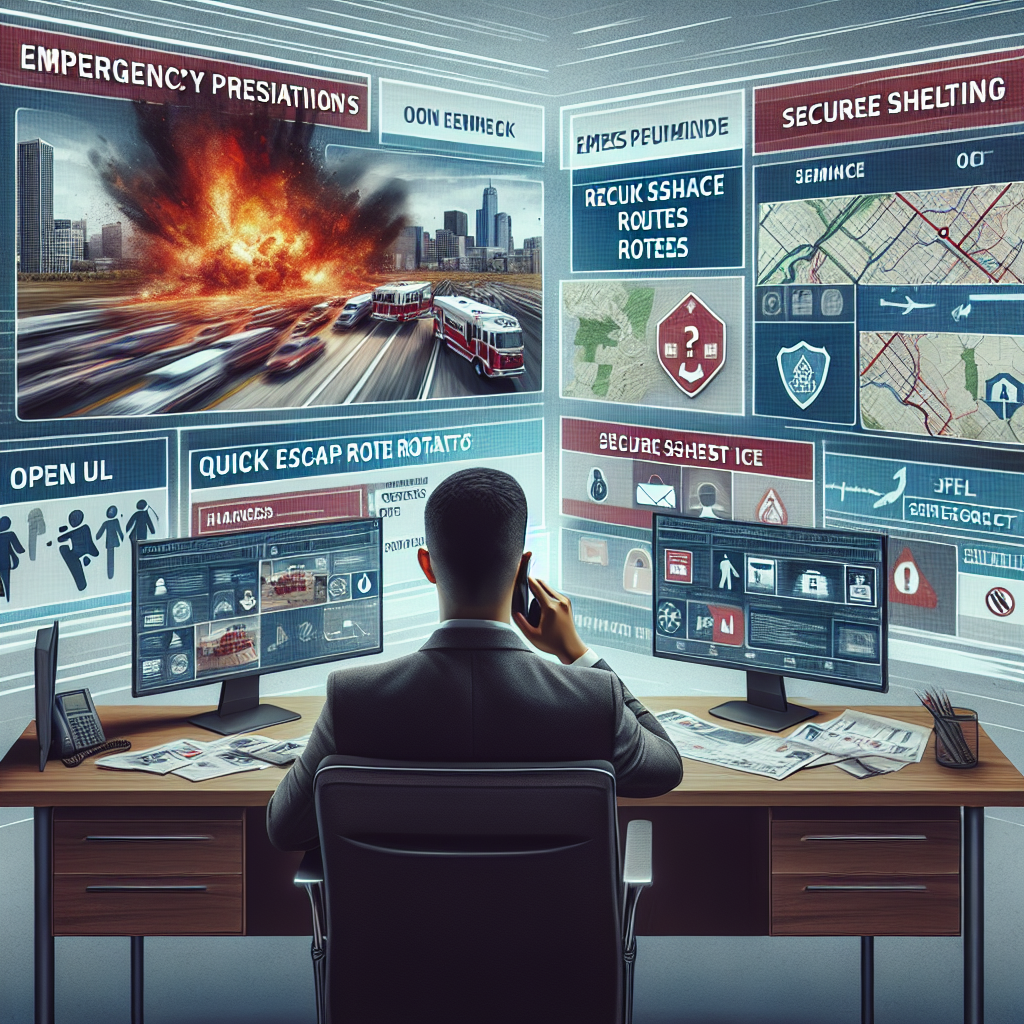Imagine finding yourself in an unexpected and terrifying situation – an active shooter scenario. In these moments where every second counts, it is crucial to know how to respond. This article aims to provide you with vital information and practical tips on what actions to take in such a dire circumstance. By understanding the steps to ensure your safety and the safety of those around you, you can empower yourself to navigate an active shooter situation with confidence and increase the chances of a positive outcome.
Preparation
Know the Warning Signs
Knowing the warning signs of potential violence is crucial for staying safe in an active shooter situation. Be aware of any behavior that may be aggressive, threatening, or preoccupied with violent themes. Look out for individuals who exhibit social isolation or withdrawal, expressions of anger or hatred, or an unusual fascination with firearms. Recognizing these signs can help you identify potential threats early on and take appropriate action.
Develop an Emergency Plan
Creating an emergency plan is an essential part of preparedness. Gather your family, colleagues, or classmates and develop a plan that outlines the steps to take in the event of an active shooter situation. Determine escape routes, designate meeting points, and identify safe areas or shelter-in-place locations. Assign specific responsibilities to each person to ensure a coordinated response. Regularly practice and update your plan to ensure everyone is familiar with their roles and the procedures to follow.
Become Familiar with the Surroundings
Being familiar with your surroundings is crucial in an active shooter situation. Take time to learn the layout of your workplace, school, or any public place you frequently visit. Map out exits and entry points, identify potential hazards or obstacles, and understand emergency security features. This knowledge will enable you to make quick decisions and determine the safest course of action should an emergency occur.
Identify Escape Routes
When faced with an active shooter situation, knowing your escape routes is essential. Identify multiple escape routes in your environment and maintain an awareness of where they are located. This knowledge will allow you to react quickly and evacuate safely. Keep in mind that the nearest exit may not always be the safest option, so be prepared to adapt your plan based on the circumstances.
Designate Meeting Points
In the chaos of an active shooter situation, it is crucial to establish designated meeting points. These meeting points serve as a gathering place for you and your loved ones to reunite after escaping or finding a safe location. Choose easily identifiable areas away from the immediate danger zone. By designating meeting points in advance, you can alleviate confusion and ensure everyone is accounted for in the aftermath of an event.
During an Active Shooter Situation
Stay Calm and Assess the Situation
Remaining calm and assessing the situation is essential during an active shooter incident. Take a moment to evaluate the environment and determine the best course of action. Avoid panicking or making impulsive decisions, as this can put you and others at risk. Stay focused, observe your surroundings, and gather as much information as possible to inform your next steps.
Run if Possible
If running is a viable option, it is often the best course of action during an active shooter situation. Quickly and quietly move away from the sounds of gunfire and danger. Keep your hands visible as you run, and encourage others around you to follow suit. Do not hesitate or look back until you reach a safe location. Running to safety should be your immediate priority.

Hide if Running is Not an Option
If running is not a safe option, finding a place to hide and protect yourself becomes crucial. Look for rooms that can be locked or barricaded, preferably without windows. Barricade doors with heavy objects and use furniture or other items as shields. Silence your electronic devices, including cell phones, and turn off any sources of noise. Make yourself as inconspicuous as possible and remain quiet until you receive additional instructions or believe it is safe to do otherwise.
Barricade Doors and Use Heavy Objects as Shields
If hiding is your only option, it is crucial to secure your hiding place. Barricade doors with desks, chairs, or any other heavy objects you can find. Create a barrier that can deter the shooter or impede their progress. Use furniture or other sturdy items as shields to protect yourself and others in your hiding location. The goal is to make it as difficult as possible for the shooter to enter and harm you.
Silence Your Devices
During an active shooter situation, silence your devices, including cell phones. Silent mode prevents any potential noise that could alert the shooter to your whereabouts. Turn off vibration as well, as it can still produce noise that may give away your position. Keep in mind that communicating with others outside your hiding place should only occur when it is safe to do so.
Communicate Only when Safe
While it is important to keep loved ones informed and updated, communicating during an active shooter situation should only occur when it is safe to do so. Prioritize your safety and the safety of those around you. If you are in a hiding place, maintain silence until given further instructions or until you are certain it is safe to communicate. Coordinating with others should be done discreetly to minimize the risk of detection.
Do Not Challenge or Confront the Shooter
In an active shooter situation, it is essential to remember that your primary goal is to survive. Do not attempt to challenge or confront the shooter unless you have no other options and your life is in imminent danger. Engaging with the shooter can escalate the situation and put yourself and others at greater risk. Instead, focus on finding a safe location or following the instructions of law enforcement personnel.
Interacting with Law Enforcement
Remain Calm and Keep Hands Visible
When law enforcement arrives at the scene of an active shooter situation, it is crucial to remain calm and keep your hands visible. Law enforcement personnel need to be able to quickly identify individuals who may pose a threat. Avoid making any sudden movements and calmly follow their instructions.
Follow Immediate Instructions
Law enforcement officers are trained to handle active shooter situations. Follow their immediate instructions without hesitation. Their primary goal is to neutralize the threat and ensure the safety of everyone involved. Cooperate fully and follow their guidance to the best of your ability.

Avoid Sudden Movements
To prevent any misunderstandings or potential harm, avoid making any sudden movements. Sudden actions may be misconstrued as a threat by law enforcement officers, who are in a high-stress and potentially dangerous situation themselves. Keep your movements slow, deliberate, and in line with the instructions given to you by the officers.
Do Not Approach Officers
During an active shooter situation, it is crucial to remember that law enforcement is there to protect you. However, refrain from approaching officers unless explicitly instructed to do so. Sudden movements or approaching officers without permission can complicate their ability to handle the situation effectively. Allow them to control the scene and follow their directions accordingly.
Provide Information Accurately
When interacting with law enforcement, provide any relevant information accurately and to the best of your ability. If you have any knowledge of the shooter, such as a description or a number of individuals involved, provide that information promptly. Additionally, share any information about injuries or hostages that may assist law enforcement in their response efforts. Accurate and timely information can aid in resolving the situation swiftly and safely.
Post-Event Steps
Account for Everyone
After an active shooter situation, one of the most critical steps is accounting for everyone who was present. Check in with your family, colleagues, or classmates to ensure their safety. Use designated meeting points established in your emergency plan to reunite and verify that everyone has successfully escaped or found a safe location. Promptly report any missing individuals to the appropriate authorities.
Seek Medical Attention for Injuries
In the aftermath of an active shooter incident, seek medical attention for any injuries you may have sustained. Even seemingly minor injuries should be assessed by a medical professional to ensure proper treatment and prevent potential complications. Promptly report any injuries to medical personnel, providing accurate information about the incident to assist with diagnosis and treatment.
Document the Incident
Documenting the incident is crucial for investigations and insurance purposes. Record any details you recall, including the time, location, and sequence of events. Take photographs of any visible damage or injuries, if it is safe to do so. Collect any relevant information, such as witness statements or contact details, to aid law enforcement and insurance companies in their investigations.
Seek Emotional Support
Experiencing an active shooter situation can be traumatic and may have long-lasting emotional effects. It is essential to seek emotional support to help process the event and cope with any resulting stress or anxiety. Reach out to professionals trained in trauma counseling or seek support from loved ones. Participate in support groups or seek out resources that can provide guidance and assistance during the healing process.

Review and Update Emergency Preparedness
After an active shooter incident, it is crucial to review and update your emergency preparedness plans. Analyze the response to identify any areas for improvement and make necessary adjustments. Conduct meetings or discussions to share insights and experiences that can enhance future emergency preparedness. Stay informed about best practices and emerging strategies to ensure you are continuously adapting and improving your readiness.
Training and Education
Participate in Active Shooter Drills
Participating in active shooter drills is an effective way to increase preparedness and readiness. By simulating an active shooter situation in a controlled environment, individuals can practice the necessary actions and responses. These drills allow for familiarization with emergency procedures, the identification of strengths and weaknesses, and the opportunity to refine strategies and communication.
Attend Safety Workshops or Seminars
Safety workshops and seminars offer a valuable opportunity to learn from experts in the field. Attend sessions that provide information and training on active shooter response and prevention. These events often cover topics such as situational awareness, decision-making under stress, and effective communication during emergencies. Stay informed about upcoming workshops or seminars in your community and take advantage of these resources.
Provide Training for Employees or Students
If you are an employer or in an educational setting, providing training for employees or students is crucial for their safety. Engage professionals experienced in active shooter response and prevention to conduct comprehensive training sessions. Equip individuals with the knowledge and skills needed to navigate these challenging situations confidently. Regularly schedule refresher courses to ensure this knowledge stays fresh and relevant.
Stay Informed about Best Practices
Active shooter response and prevention strategies are continually evolving. Stay informed about the latest best practices and recommendations from reliable sources such as law enforcement agencies, government organizations, or reputable safety experts. Keeping up-to-date with the latest information empowers you to make informed decisions and adapt your emergency plans accordingly.
Share Knowledge within the Community
Knowledge is best shared when it benefits the entire community. Take the initiative to educate others about active shooter response and prevention measures. Share what you have learned from training, workshops, or personal experiences to raise awareness and increase preparedness levels within your community. By fostering a culture of preparedness and safety, you contribute to a safer environment for everyone.
Recognizing Warning Signs
Aggressive or Threatening Behavior
Recognizing aggressive or threatening behavior is essential for early intervention. Be attentive to individuals who consistently display anger, hostility, or aggression. Look out for individuals who frequently engage in confrontations or exhibit a pattern of intimidating behaviors. If you observe these signs, consider reporting your concerns to appropriate authorities who can assess the situation further.

Preoccupation with Violent Themes
Individuals preoccupied with violent themes may pose an increased risk. Pay attention to those who consistently express fascination or excessive interest in violence, particularly towards others. This preoccupation may manifest through conversations, online behavior, or a fascination with weaponry or violent media. If you notice these signs, it is crucial to alert the appropriate authorities and provide them with the necessary information.
Social Isolation or Withdrawal
Social isolation or withdrawal from personal relationships can also be warning signs of potential violence. Take notice if someone begins to distance themselves from friends, family, or coworkers without an apparent reason. Drastic changes in behavior, such as a sudden loss of interest in activities or a decline in personal hygiene, may indicate a need for intervention or support.
Expressions of Anger or Hatred
Expressions of anger or hatred, especially when directed towards a particular individual or group, should not be ignored. Pay attention to individuals who regularly make threats, talk about seeking revenge, or display intense hostility towards others. These expressions may be verbal, written, or expressed through social media. If you come across such behavior, it is essential to report it to the appropriate authorities immediately.
Unusual Fascination with Firearms
An unusual fascination with firearms can indicate a potential risk. Take note of individuals who have an excessive interest in firearms, display an extensive knowledge of weaponry, or express a desire to obtain or use firearms without a legitimate reason. This fascination may be accompanied by dangerous ideations or behaviors. If you observe this warning sign, it is crucial to notify the appropriate authorities for further investigation.
Developing an Emergency Plan
Identify Emergency Contacts
When developing an emergency plan, it is essential to identify and share emergency contacts. These contacts should include local law enforcement, emergency services, and any designated authorities within your organization or educational institution. Save these numbers in your phone, write them down in a readily accessible location, and share them with all individuals involved in your emergency plan.
Establish Communication Channels
Establishing clear and reliable communication channels is crucial during an emergency. Identify multiple modes of communication, such as phone calls, text messages, or social media platforms, to ensure that you can stay in contact with your loved ones, colleagues, or classmates. Determine backup methods in case one mode of communication is compromised or unavailable.
Determine Evacuation Procedures
Knowing the evacuation procedures for your environment is essential for a swift and safe response. Determine the designated evacuation routes and assembly points for your workplace, educational institution, or any public places you frequent. Familiarize yourself with the protocols for evacuating individuals with mobility restrictions or disabilities to ensure their safety as well.

Assign Responsibility for Different Tasks
Assigning specific responsibilities to individuals within your emergency plan promotes a well-coordinated and effective response. Designate roles such as contacting emergency services, guiding others to safety, or providing first aid. Clearly communicate these responsibilities and ensure that everyone understands their role and knows how to carry out their assigned tasks in an emergency.
Regularly Practice and Update the Plan
Practicing your emergency plan regularly is crucial to ensure its effectiveness. Conduct drills or simulations to practice evacuations, communication, and coordination. Identify any areas that require improvement and make updates accordingly. Keep all individuals involved in the emergency plan informed of any changes or updates, and schedule regular review sessions to ensure everyone remains knowledgeable and prepared.
Knowing the Surroundings
Map Exits and Entry Points
Knowing the locations of exits and entry points is essential for your safety. Take time to identify and map out all possible exits in your environment. Be aware of primary and alternative exit routes to adapt quickly in an emergency. Familiarize yourself with the locations of doors, windows, and any other potential means of escape. This knowledge will empower you to make informed decisions and take swift action.
Identify Safe Areas or Shelter-in-Place Locations
In some situations, running or evacuating may not be immediately possible. In such cases, it is crucial to identify safe areas or shelter-in-place locations. These areas should be fortified and offer protection against potential danger. Examples include rooms with reinforced doors, minimal windows, and access to emergency supplies. Be vigilant in identifying these areas wherever you are, and share this information with others in your emergency plan.
Know the Layout of Surrounding Buildings
Having knowledge of the layout of surrounding buildings can be beneficial during an active shooter situation. Identify nearby buildings, such as neighboring businesses or schools, and become familiar with their structure and layout. This information can be valuable when determining alternative escape routes or identifying nearby safe areas. Building awareness of your surroundings extends beyond immediate locations and can facilitate safer decision-making.
Identify Potential Hazards or Obstacles
Being aware of potential hazards or obstacles in your environment can aid in a quick and safe response during an active shooter situation. Identify any potential hazards, such as heavy machinery, construction sites, or areas with limited visibility. Also, take note of any obstacles that may impede your escape or hinder your ability to hide effectively. This awareness allows you to proactively plan and adapt your response based on the specific circumstances.
Understand Emergency Security Features
Understanding the emergency security features available in your environment is instrumental in an active shooter situation. Familiarize yourself with how to activate emergency alarms, lockdown procedures, or any other security measures specific to your workplace, school, or public places. Knowing how to access and utilize these features ensures a more efficient response and enhances overall safety.
Running to Safety
Leave Personal Belongings Behind
When running to safety in an active shooter situation, it is crucial to prioritize your well-being over personal belongings. Leave behind any items that may slow you down or hinder your ability to escape. Remember that your life is the most important thing, and material possessions can be replaced.
Keep Hands Visible
Maintaining visible hands as you run to safety is essential to avoid being mistaken as a threat. Law enforcement personnel arriving at the scene need to be able to assess the situation quickly. Keep your hands away from your pockets and avoid carrying anything that may be perceived as a weapon.
Move Away from Gunfire and Danger
When running to safety, the primary objective is to move away from gunfire and any immediate danger. Seek out exit routes that take you as far away from the source of the threat as possible. Follow evacuation procedures if available, and urge others around you to run with you to safety.
Encourage Others to Run as Well
During an active shooter situation, it is crucial to work together to increase the chances of survival. Encourage others around you to run to safety, maintaining a calm and reassuring manner. Provide guidance to those who may be in a state of panic, helping them identify the best escape routes and supporting them throughout the process.
Do Not Stop Until Reaching a Safe Location
While it may be tempting to stop running once you have distanced yourself from immediate danger, it is important to keep moving until you reach a safe location. Continue to follow escape routes and adhere to evacuation procedures until you are out of harm’s way. A safe location may include designated meeting points or areas identified as secure during your emergency planning.
Providing Information to Law Enforcement
Stay Calm and Comply with Instructions
When providing information to law enforcement in an active shooter situation, it is essential to stay calm and follow instructions. Approach officers with visible hands and communicate calmly and clearly. Avoid making any sudden movements or gestures that may be perceived as a threat. Cooperation and compliance are vital for law enforcement to effectively respond and neutralize the threat.
Give the Number of Intruders, if Known
If you have any knowledge of the number of intruders, provide that information promptly and accurately to law enforcement. Knowing the number of individuals involved in an active shooter situation helps law enforcement assess the threat appropriately and plan their response accordingly. Be as specific as possible when providing this information.
Provide a Description of the Shooter
If you are able to do so safely, provide law enforcement with a detailed description of the shooter. Pay attention to important identifiers such as physical appearance, clothing, or any distinguishing features. This information can aid significantly in locating and apprehending the individual responsible for the incident.
Mention Locations and Time of Last Sightings
Providing law enforcement with information on the locations and time of the shooter’s last sightings can help them establish the shooter’s movements and anticipate their potential next steps. Share any relevant information you have regarding the shooter’s movements within the environment. These details can assist law enforcement in their search and response efforts.
Share Any Information on Injuries or Hostages
If you have information about injuries or hostages within the environment, relay that information to law enforcement. Accurate and timely information regarding the presence of injured individuals or individuals held hostage can help shape the response tactics of law enforcement. Be specific and provide as much detail as possible to aid in their assessment and decision-making process.






